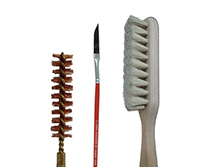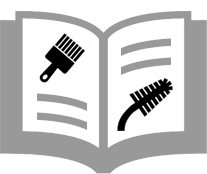As the name implies, static electricity is electricity at rest. The electrical charge is the transference of electrons that occurs when there is sliding, rubbing, or separating of a material, which is a generator of electrostatic voltages. For example: Under the right conditions, material such as plastics, fiberglass, rubber, textiles, etc. can induce a charge that can reach 30,000 to 40,000 volts.
When this happens to an insulating material, like plastic, the charge tends to remain in the localized area of contact. This electrostatic voltage may then discharge via an arc or spark when the plastic material meets a body at a sufficiently different potential, such as a person or microcircuit.
The need to solve static generation and dissipative problems has grown in the electronics industry and in particular, the computer chip industry. The issue is not solely because of the increase in the computer chip use, but more so due to the increased density of the chips. As industry puts more and more on a single chip, the layers inside the chips are getting smaller and smaller, making them more susceptible to the effects of ESD (Electrostatic Discharge) and EOS (Electrostatic Overstress). When static charge of less than 10 volts will destroy a class 1 ESD sensitive device and it is possible to create a static charge of over 35,000 volts walking across a carpet on a dry day, the problem is immediate and severe. Gordon Brush® is solving this problem with ESD Brushes.
Static charge is generated between materials through friction, pressure, or separation of two materials, one of which is usually non-conductive. This process is called the Triboelectric Effect [tribo means rubbing]. The actual level of charge is measured in coulombs. Commonly, however, the electrostatic potential on an object is expressed as a voltage.
In addition to the material composition, applied forces and separation rate, relative humidity is an important factor in the generation of static charges. When humidity is low, higher static charges are generated more easily. Static becomes more noticeable in the winter months, in dry climates, and in air-conditioned environments. Increasing humidity to 60% limits static build-up as surface moisture on materials makes a good conductor. Unfortunately, 60% relative humidity is extremely uncomfortable, can cause equipment problems, and introduce contaminants.
EOS occurs when an electronic device is exposed to a strong static electric field generated by a static charge. Internal electronic components stressed beyond their designed tolerances may fail immediately or have reduced service lives
ESD occurs when two objects of different electrostatic potentials are brought close enough together to allow a charge transfer. ESD is the sudden discharge of this electrostatic potential from one body to another. If the discharge current exceeds designed tolerances, damage may cause immediate failure or result in reduced service life.
ESD Brush Material Definitions & Properties
Materials for static control of brushes are placed in one of three classes: Conductive, Dissipative, and Insulative. Additionally, there is a commonly accepted category referred to as Antistatic.
Electrostatic Discharge (ESD)
The sudden flow of electricity between two electrically charged objects caused by contact, an electrical short, or dielectric breakdown. Static electricity buildup can be caused by the triboelectric effect or by electrostatic induction
The triboelectric effect (also known as triboelectric charging) is a type of contact electrification on which certain materials become electrically charged after they are separated from a different material with which they were in contact. Rubbing the two materials with each other increases the contact between their surfaces, and hence the triboelectric effect. Rubbing glass with fur for example, or a plastic comb through the hair, can build up triboelectricity. Most everyday static electricity is triboelectric. The polarity and strength of the charges produced differ according to the materials, surface roughness, temperature, strain, and other properties.
Electrostatic induction is the modification in the distribution of electric charge on one material under the influence of nearby objects that have electric charge. Thus, because of the electric force between charged particles that constitute materials, a negatively charged object brought near an electrically neutral object induces a positive charge on the near side and a negative charge on the far side of the neutral object. The neutral object, furthermore, may sometimes become charged positively by induction, if its negative part is grounded momentarily to permit the negative charge to escape. Electrostatic induction occurs whenever any object is placed in an electric field.
Conductive Brush Materials allow charges to move freely across their surfaces or through their volume. Charge placed in one spot on a conductive object will flow around the object so that all parts of the object are equally charged. If a charged conductor is grounded, charges will recombine [move to ground] until the object has no charge. Conductive materials have a low resistance to current flow. One common misconception is that conductive materials do not generate charges. This is because the dissipation of static charges from grounded conductive material tends to be complete and rapid. Ungrounded conductors can generate and hold static charges. Conductive materials have a surface resistivity less than 1 x 105 Ω/sq or a volume resistivity less than 1 x 104 Ω-cm.
Dissipative Brush Materials allow charges to move more slowly across their volume. Charge placed in one spot on a dissipative object will flow around the object so that all parts of the object share the same charge. If a charged dissipative material is grounded, charges will recombine at a slower rate until the object has no charge. Dissipative materials have a resistance to current flow that is greater than conductors, but less than insulators. Dissipative materials have a surface resistivity equal to or greater than 1 x 105 Ω/sq but less than 1 x 1012 Ω/sq or a volume resistivity equal to or greater than 1 x 104 Ω-cm but less than 1 x 1011 Ω-cm.
Insulative Brush Materials do not allow charges to move across their surfaces or through their volume. Charge placed in one spot on an insulative object will stay in that location. If a charged insulator is grounded, charges will not move to ground. Grounding is not an effective method of neutralizing insulators. Insulators can have both negatively and positively charged areas on the same object. Because insulators do not allow charge movement, they can accumulate massive amounts of charge. Static fields on insulators are not necessarily permanent; they will eventually be neutralized by gradual recombination with free ions. Insulative materials are defined as those having a surface resistivity of at least 1 x 1012 Ω/sq or a volume resistivity of at least 1 x 1011 Ω-cm.
Antistatic (Anti-Static) Brush Materials as defined by the ESD Association, refers to the property of a material that inhibits triboelectric charging. A material that inhibits the generation of static charges [generally less than 200 volts] from triboelectric generation is classified as antistatic. These materials would be arranged in the triboelectric series near cotton, an electrically neutral material. Materials ordered in either side of cotton generate some static charge, but in very small amounts. Note: a material's antistatic characteristic does not necessarily correlate with its resistivity. An antistatic material can be conductive, dissipative, or even insulative. Antistatic or dissipative materials should be used in ESD safe areas, while contact with a conductive material can damage a charged device.
DOWNLOAD PDF

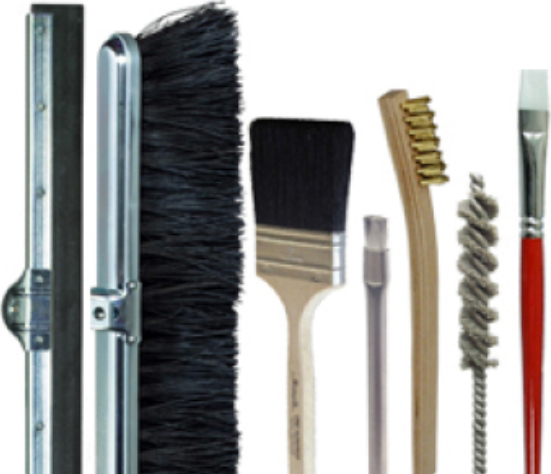
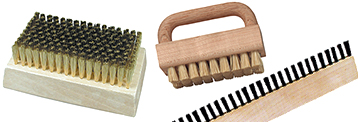 Block Brushes
Block Brushes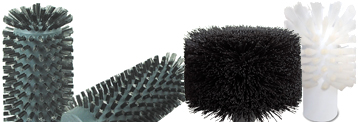 Bore Brushes
Bore Brushes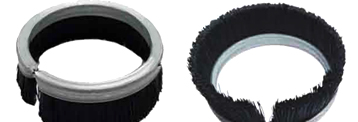 Cup Brushes
Cup Brushes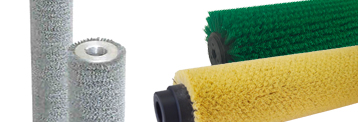 Cylinder Brushes
Cylinder Brushes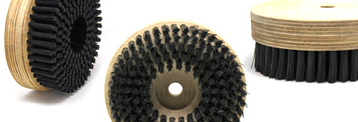 Disk Brushes
Disk Brushes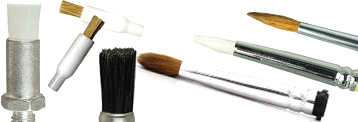 Flow Thru Brushes
Flow Thru Brushes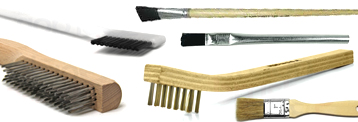 Hand Held Brushes
Hand Held Brushes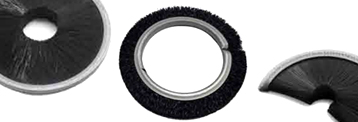 Inward & Outward Disk Brushes
Inward & Outward Disk Brushes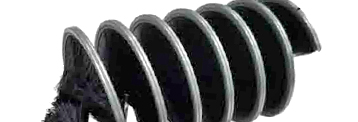 Inward Wound Coil Brushes
Inward Wound Coil Brushes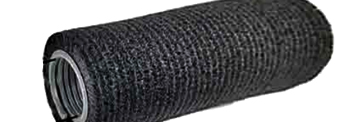 Outward Wound Coil Brushes
Outward Wound Coil Brushes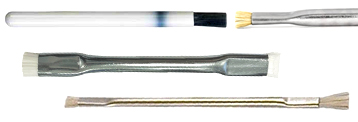 Pencil & Applicator Brushes
Pencil & Applicator Brushes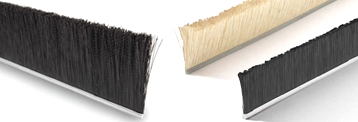 Straight Strip Brushes
Straight Strip Brushes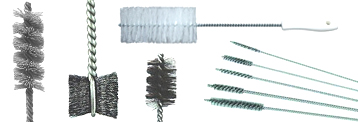 Twisted-In-Wire Brushes
Twisted-In-Wire Brushes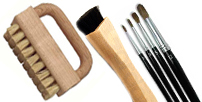 Natural Fill Brushes
Natural Fill Brushes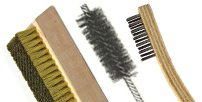 Wire Fill Brushes
Wire Fill Brushes Synthetic Fill Brushes
Synthetic Fill Brushes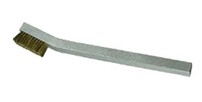 Metal Handle Brushes
Metal Handle Brushes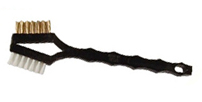 Plastic Handle Brushes
Plastic Handle Brushes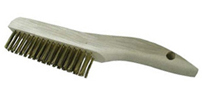 Wood Handle Brushes
Wood Handle Brushes